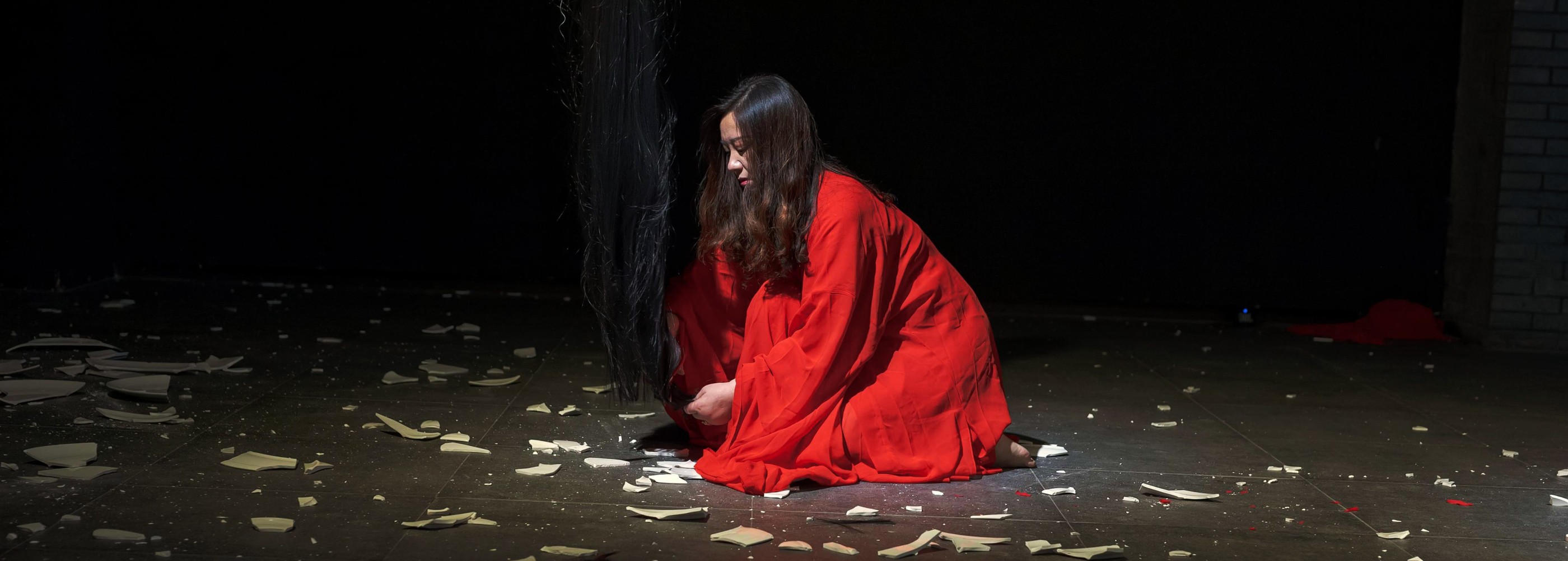

I find myself in a particularly unique era where performance art has been largely alienated, and there are many things that artists cannot directly express. The location of this exhibition is a museum, so I thought of a "performance theater," a way to incorporate elements of reality into the performance. I often wonder, in the darkest moments when I cannot directly confront reality, how can I express myself? That's when I thought of mythology. Mythology is allegorical, symbolic, and metaphoric. Mythical stories can establish connections and dialogues with contemporary society. This led to the fusion of a seven-day performance with theater.
Visible and Invisible - Li Xinmo Performance Theater:
Scene One: "The Golden Age"
October 1, 2022, at 4:30 PM
Scene Two: "Medea"
October 2, 2022, at 3:00 PM
Scene Three: "Antigone"
October 3, 2022, at 3:00 PM
Scene Four: "Leda in the Water"
October 4, 2022, at 3:00 PM
Scene Five: "Tethys"
October 5, 2022, at 3:00 PM
Scene Six: "Prometheus"
October 6, 2022, at 3:00 PM
Scene Seven: "The Iron Age"
October 7, 2022, at 3:00 PM
Xinmo Theater - Day One: "The Golden Age"
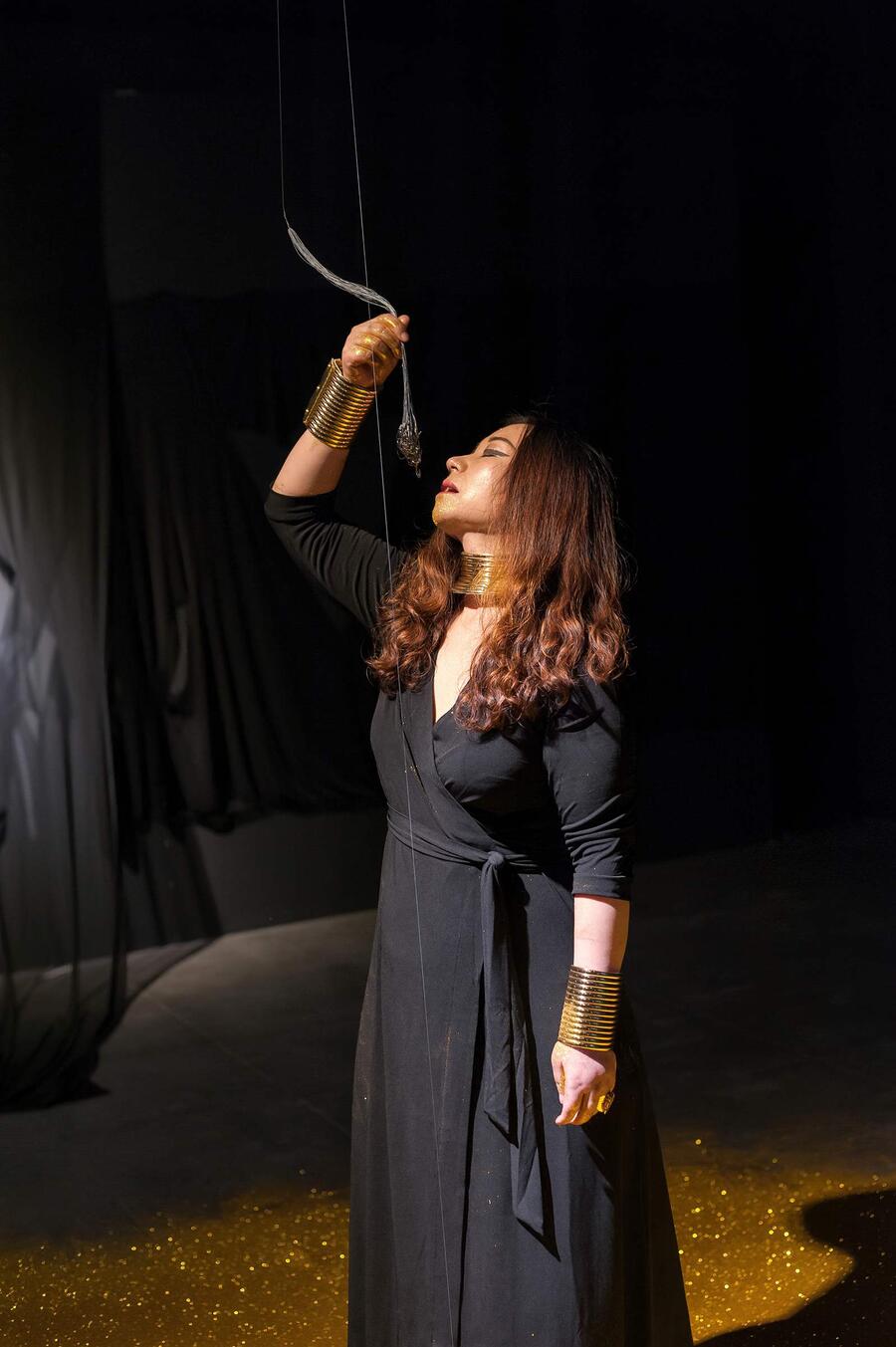
"The Golden Age" is derived from the "Five Ages of Man" in ancient Greek mythology.
The exhibition takes place from October 1st to 7th, a time often referred to as the golden autumn season. In the northern regions, it's a time when the leaves turn yellow, and the harvest season begins. Additionally, it coincides with the National Day holiday. So, my initial thought was "The Golden Age." This National Day holiday evokes complex emotions within me because an important conference is scheduled during this period, signifying that the country would enter a darker era of dictatorship. In a time of censorship. How can I express myself? How can I create art when confronted with such circumstances? I kept asking myself these questions. I attempted to engage in a metaphorical and allegorical dialogue between real events and social scenes with those ancient myths. In a sense, even the name "The Golden Age" itself carries a sense of irony. The "Golden Age" refers to a period from 1710 BC to 1674 BC, which corresponds to the rule of Cronus. It was a time when humans lived carefree and happily alongside the gods, obediently following the gods' will. They didn't need to labor for food, their bodies were strong, and they didn't worry about disease or death. Clearly, I am not living in a golden age, so the answer I ultimately provide in the last scene is "The Iron Age," creating a contrasting relationship.
When conceptualizing "The Golden Age," the first thing that came to mind was color—gold. So, I chose a special gold powder material. A golden heart serves as the central point of this artwork. Fishhooks are connected to this heart, symbolizing the connection between the heart and pain. I have witnessed fishing scenes where fish struggle desperately when hooked and pulled up, and I could sense the pain of the fish. In a way, the people living here are like overcrowded fish in a pond, waiting for their fate to be lifted by a fishhook and placed on a chopping board. So, I thought about fishhooks, continuously imagining a scene where a string of fishhooks is inserted into the mouth simultaneously—a pain that cannot be expressed.
The museum's exhibition wall is black, and I used one wall as a backdrop. A cross-shaped installation made of black gauze is set up on the wall. In front of this installation hang the heart and fishhooks. White porcelain plates surround the plate holding the heart, and each plate contains gold powder. The heart, fishhooks, white porcelain plates, and gold powder form a symbolic installation. This installation creates an immersive atmosphere.
The symbolism of the heart comes from ancient Egypt. When preparing a body for burial, the ancient Egyptians would remove the organs one by one. During the process of mummification, they held the heart of the deceased in high regard, believing that it recorded the good and evil deeds of the deceased throughout their life. The ancient Egyptians would place the heart in a jar or return it to the chest cavity of the deceased, allowing the heart to be weighed against the feather of the goddess Ma'at in the afterlife. Ma'at was the goddess of truth and justice in ancient Egypt and had the authority to judge whether the heart's owner had been virtuous during their lifetime. If the heart weighed less than Ma'at's feather, the deceased would enjoy eternal life in the afterlife. If the heart weighed more, it would be immediately devoured by the monster Ammit, waiting beneath the scale. In a way, the heart served as the measure of justice and morality.
My clothing also draws inspiration from the colors and elements of ancient Egypt. Black and gold constitute the main color scheme of this artwork. Gold was a symbol of the sun in ancient times, representing eternity and immortality. Gold was abundant in the sculptures, crafts, and paintings of ancient Greece and ancient Egypt, as well as in the sculptures and paintings of Christianity and Buddhism. The golden heart also carries the symbolism of purity and an immaculate heart. Moreover, the golden heart is a universal characteristic of people in the Golden Age. Therefore, the people of the Golden Age were the closest to divinity, understanding the heavens and the earth, and receiving protection and blessings, just like humans in the Garden or in their childhood, a time when people had undiscriminating hearts, were without deceit, ulterior motives, or hatred.
I initially stood behind a black veil, my body obscured by it. I used a knife to cut open the black veil, revealing myself through the slits. Light also shone through the cracks and onto me. That process was like using a knife to cut through the night, revealing the light in the quest for truth.
I approached a row of porcelain plates arranged with the heart at the center. I then grabbed the gold powder and blew it, just like the Dream God Morpheus blowing golden sand to create dreams. I lifted the porcelain plate, and the golden powder scattered in my hand, surrounding the heart, layer by layer, forming a circular golden field. At this moment, I became quiet and stared at the row of fishhooks hanging in the air. I gradually approached and put the fishhooks into my mouth. Stinging, discomfort, sharpness, coldness, rigidity, sharpness—48 fishhooks filled my oral cavity. I needed to be extremely focused, biting down on the fishhooks tightly with my teeth. Slowly, my body moved downward, and the heavy golden heart, fixed at the other end of the fishing line, rose gently. It was a moment filled with adventure and tension, and any negligence could lead to unpredictable consequences. The consequences of forcefully pulling 48 fishhooks in the mouth would be an unimaginable and gruesome scene. The delicate fishing line moved slowly on the metal beam, and the heart slowly rose into the air as I gradually descended until I was lying on the ground. Finally, the golden heart and fishhooks were connected, hanging in the air. After completing the performance, I left behind the scene of an installation. In this performance, I integrated the installation and the action. The process of the action was also the construction of an installation, the creation of a space.
Xinmo Theater - Day Two: "Medea"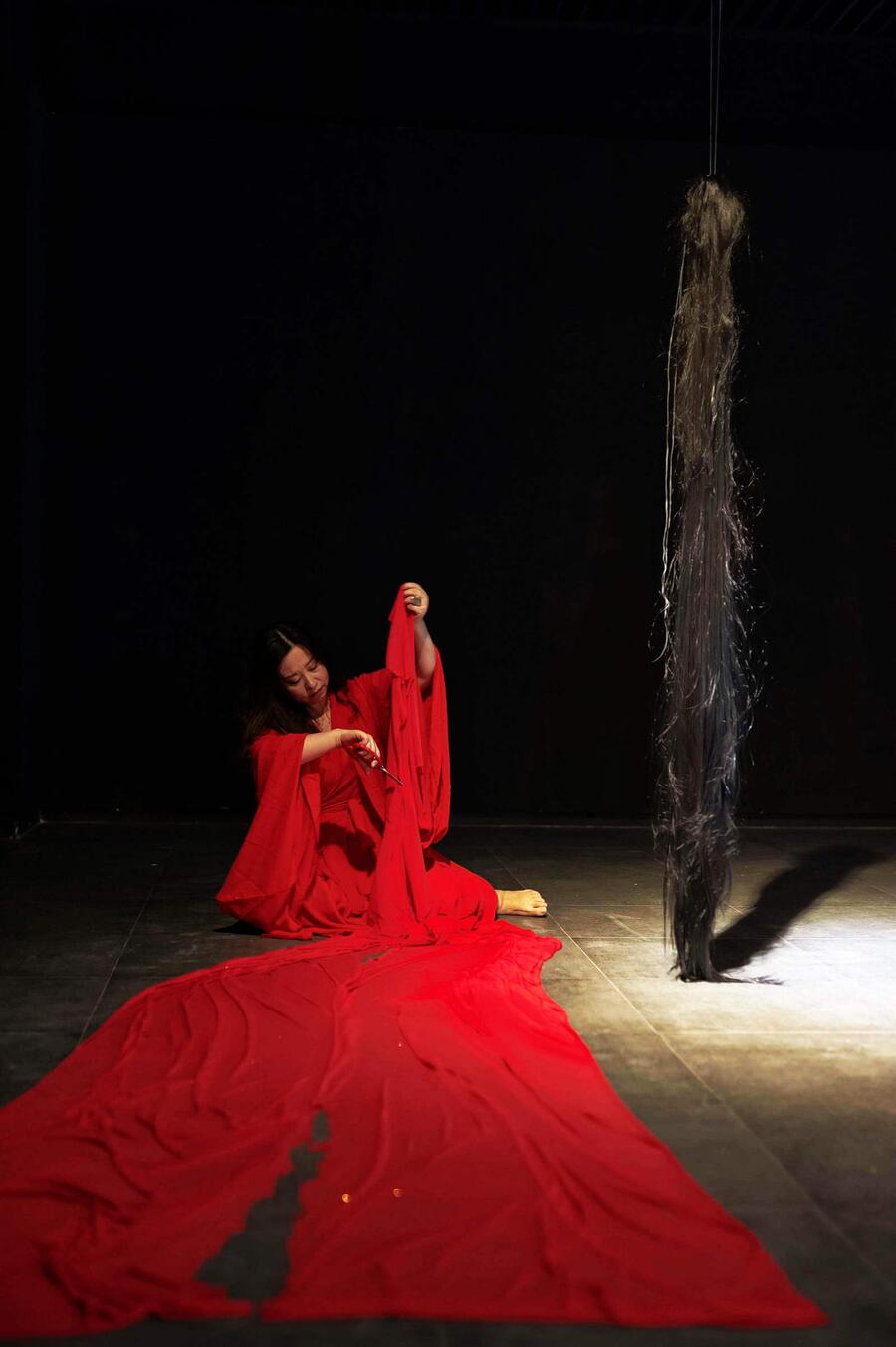
"Medea" is one of the three great tragedies of ancient Greece. Its author, Euripides, is one of the "Three Great Masters of Greek Tragedy." The tragedy tells the story of Medea, the wife of the hero Jason, who had stolen the "Golden Fleece" in the heroic age of ancient times but later abandoned his wife and their children. Medea is a character from Greek mythology, the daughter of King Aeëtes of Colchis. She fell in love with Jason at first sight, the hero of the Argo, and used her magical powers to help him obtain the Golden Fleece. Together, they eloped on a ship. However, upon Jason’s return to his homeland, he fell in love with another woman, and Medea, consumed by sorrow and anger, killed their two children born of her marriage with Jason and poisoned his new lover before fleeing to Athens.
Ten years ago, I watched a play directed by a famous Russian theater director at a friend's house. It was a production of "Medea" featuring only one actress. It featured only one actress who deeply captivated me with her performance, using only her voice, simple props, and movements. That performance conveyed immense power and shock to me. Later, I read the play "Medea" and explored the descriptions of Medea in Greek mythology. Medea's character resonated with some of my experiences, and she has become a prototype for many women in the real world. This time, I attempted to interpret "Medea" through performance art.
When conceiving this work, there was a significant hair-cutting protest movement happening in Iran. A 22-year-old woman named Mahsa Amini was beaten to death by the police for not wearing her headscarf properly, sparking massive protests in Iran and worldwide. Many Iranian women were resisting by cutting their hair, and women from other countries were showing support through the same action. Although Amini's incident was an extreme event in an Islamic state, it underscored the pervasive issue of gender inequality worldwide. And Medea's plight, in a way, represents the fate of women in a patriarchal world. Even though she is a a priestess existing in the divine realm, she shares the fate of earthly women.
I hoped to resonate and initiate a dialogue between ancient Greek mythology and contemporary society. I also attempted to integrate ongoing events and issues that had deeply affected me into my performance. In "Medea," I used a hanging two-meter-long strand of hair as the central element of the performance to symbolize the fate of women. It conveyed a strong spirit of resistance, much like Medea's, even though it was presented in the form of vengeance. In some sense, Euripides portrayed her suffering from Medea's perspective. One of the most crucial scenes in the play is when Medea kills her two children. I laid out a 4-meter-long red cloth, cut it in half with scissors, and fashioned two doll-like figures out of the halves, representing her children. These two figures were placed at opposite ends, and I held white porcelain plates in each hand, forcefully smashing them between the two figures. The shattering sound was piercing and resonated throughout the entire space, symbolizing the state of heartbreak when Medea was betrayed by her lover. I repeatedly made the two porcelain plates collide until all 18 plates were reduced to shards, which were strewn across the floor. I then walked barefoot on the shards.
In the debris of the shards, I found two red dolls and proceeded to cut them apart with scissors, reenacting the scene where Medea killed her two young children. Finally, I approached the hanging strand of long hair with scissors and slowly cut it strand by strand, letting the cut hair fall to the ground. This scene was inspired by Frida Kahlo's painting, where she wore men's clothing and held scissors, cutting her long hair strand by strand. The painting depicted a similar heart-wrenching image of betrayal by her husband Diego Rivera, but it was also an act of resistance emanating from the depths of her being as a woman. This process of cutting hair also resonated with Iran's hair-cutting protest movement.
In this way, I participated in the tragedy of Medea, hoping to infuse it with a sense of women’s resistance and self-awakening, rather than merely invoking people’s sighs and sympathy.
Xinmo Theater - Day Three: "Antigone"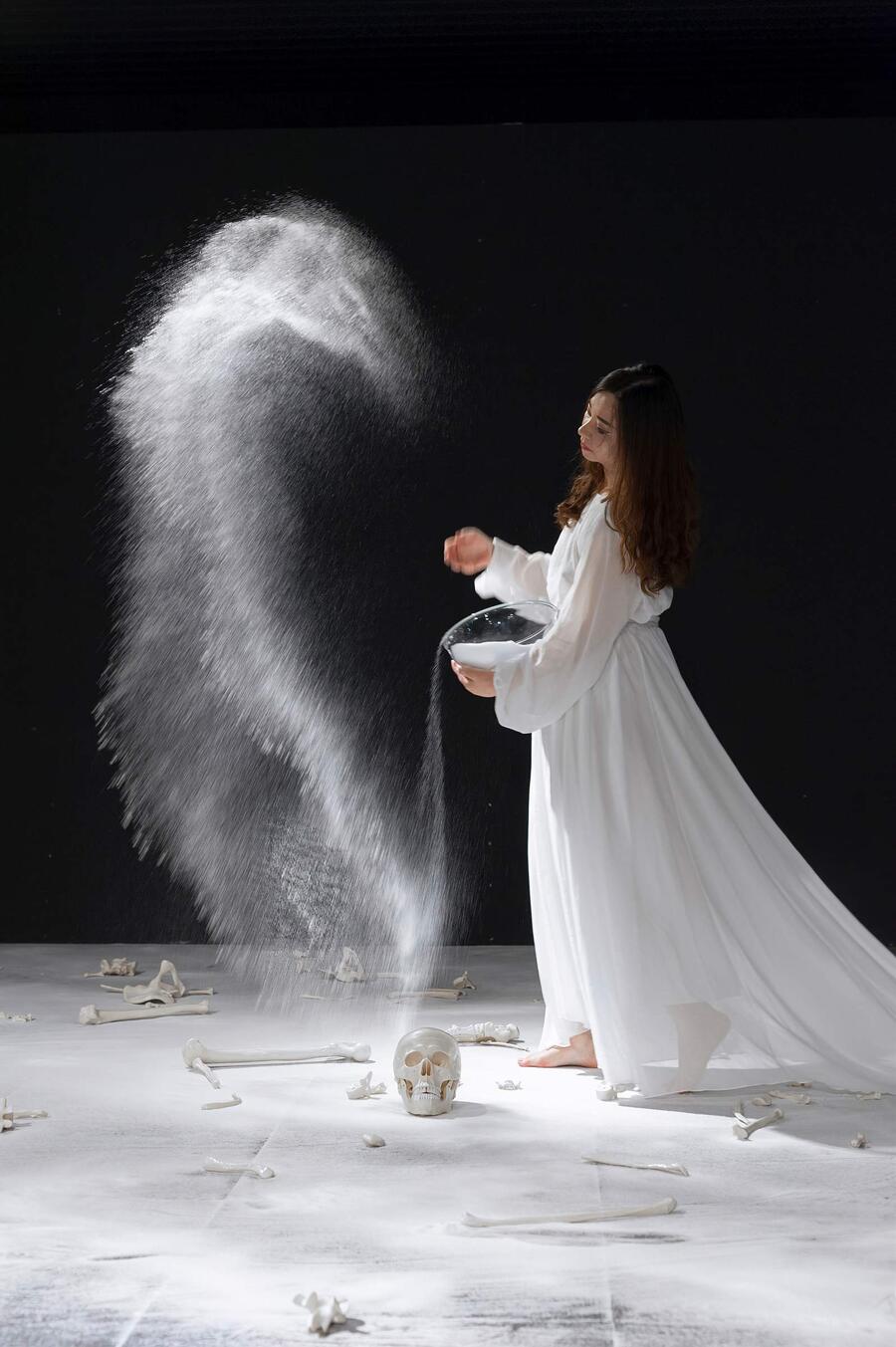
"Antigone" is a play by the ancient Greek tragedian Sophocles written in 442 BC, and it is widely recognized as one of the greatest works in the history of drama. The story unfolds in Thebes. Creon takes the throne as the new king, succeeding Oedipus. Oedipus' son Eteocles sacrifices himself to protect the city state, while his other son Polynices betrays the city state by conspiring with foreign forces to attack Thebes and dies in the battle. After the war, Creon arranges a grand funeral for Eteocles but leaves Polynices' corpse to rot in the field. Creon issues a decree that anyone who buries Polynices will be sentenced to death. Polynices' sister, Antigone, defies Creon's order and buries her brother, citing adherence to divine law as her justification. Consequently, she is sentenced to death by Creon. Meanwhile, Creon encounters a blind prophet, Tiresias, who tells him that he has offended the gods. Creon regrets his decision and rushes to save Antigone, but she has already died. Creon's son Haemon, who is also Antigone's fiancé, confronts Creon and then commits suicide. Creon's wife, Eurydice, upon hearing of her son's death, blames Creon and takes her own life. It is at this point that Creon realizes he has single-handedly caused the tragedy.
"Antigone" is a classic of ancient Greek tragedy, and its metaphorical significance has been subject to various interpretations. In the play, Antigone, while defying Creon, utters a passage that legal scholars often cite: "The unwritten, unspoken laws of the gods are eternal. They were not just for now or yesterday, but exist forever, and no one knows when they first appeared." "I do not believe that your edicts have such power that you, a mere mortal, can override the unwritten and eternal laws of the gods. They are not of today or yesterday, but they exist forever, and no one knows their origin in time!" This passage has become a classic in the debate between natural law theory and legal positivism.
In the Western context, Antigone's defiance of city state law is referred to as the "Antigone's complaint," and this tragic resentment has become one of the sources of constitutionalism, democracy, and the rule of law.
In political science and jurisprudence, Antigone symbolizes the attitude and spirit of using higher law to criticize the state's positive law. Today, our interpretations of this conflict go far beyond that, for example, interpretations from the perspective of state law and customary law, from the standpoint of love and justice/law, and interpretations of humanitarianism and positive law. Hegel only confines Antigone to the realm of family ethics and does not elevate her to the level of opposing unjust laws. The tragedians did not emphasize the tension and opposition between natural law and state law; they insisted that no one has a monopoly on virtue. For instance, Antigone's sister Ismene accuses her actions of being pretentious: "You do not love our brother; you love your own righteous stance. You want to win immortality with your stance. Your actions do not arise out of sympathy for specific life but from the fanatical passion for abstract principles." Nevertheless, Antigone, as a symbol, represents citizens standing up against unjust laws based on principles of natural law, divine law, and conscience.
This tragedy answered the debates in Athens at the time about natural law. Heraclitus said, "All human laws are nourished by one law—the divine law." Pericles stated in his speech that failing to abide by this law would bring about universally recognized shame. Thus, the tragedy aligned with the worldview of ordinary Athenians at the time—piety towards the gods and obedience to divine will. So, in the end, Creon finally realized that one should never commit the sin of disrespecting the gods, as "mortals cannot escape the inevitable disasters." The principles expounded by the tragedy were first inherited and developed by Greek philosophers, and in the subsequent Hellenistic period, the Stoic school of thought further expounded upon it, formally establishing the tradition of natural law. Through the developments by figures like Cicero, the position of natural law was formally recognized in Roman law. Since then, the tradition of natural law has continued to thrive and evolve. The significance of Antigone today lies in how it addresses the relationship between the law and citizens and how citizens should confront unjust laws.
Sophocles' "Antigone" has inspired me to create a scene involving bones, sand, and burial. I prepared 200 kilograms of salt as a replacement for sand, along with 206 human skeletal pieces. I wore a white dress and laid out the white bones on the ground. Then, I scattered the salt by hand into the space. As I continued to spread the salt, the ground started to resemble freshly fallen snow, gradually covering the white bones. I bent down and used my body to push the bones and salt until they formed a white mound, symbolizing Antigone's act of burying her brother. Next, I slowly unfolded a piece of paper, and poured out blue liquid from a water bottle. I continuously used my hands to collect the spreading blue water, as if I were gathering memories and grief related to the brother. Finally, I lay down on a white cloth and rolled from one end to the other. The white cloth enveloped my body, symbolizing Antigone's ultimate fate—death.
Xinmo Theater - Day Four: "Leda in the Water"
The story of "Leda and the Swan" originates from ancient Greek mythology and was first recorded in the written work "Metamorphoses" by the Roman poet Ovid. Leda, a princess of Etoilea, originally a sea nymph, known for her beauty. The swan, however, was none other than Zeus, the king of the gods, who possessed a penchant for amorous pursuits and the ability to transform into various creatures. At that time, King Tyndareus of Sparta was exiled by his brothers and found refuge in Etoilea. The king of Etoilea admired Tyndareus and decided to marry his daughter Leda to him. After going through a period of hardship in his life, Tyndareus was delighted to have married a beautiful wife and became so complacent that he forgot to pay tribute to Aphrodite, and as a result, he faced her revenge. However, Aphrodite did not directly retaliate against Tyndareus but instead targeted his wife, Leda, with a cunning plan. One fateful day, while Leda was bathing in the lake, Aphrodite transformed Zeus into a swan and herself into an eagle. The eagle chased the swan, and Zeus, in the form of the swan, sought refuge by the lake. Unintentionally, Zeus caught sight of the beautiful bathing Leda and immediately fell in love with her. He landed beside her. Leda was captivated by the swan but remained unaware that it was Zeus in disguise. Taking advantage of the swan's form, Zeus seduced Leda, who was defenseless, and they engaged in a sexual relationship. As a result of their union, Leda gave birth to Zeus' child. This timeless tale has captivated artists across the ages, inspiring countless artistic interpretations, from the works of da Vinci to Boucher. However, these depictions of Leda and the Swan predominantly focus on the celebration and expression of desire. In contrast, W.B. Yeats' poem offers a different perspective, emphasizing the elements of seduction and violence within the story.
Leda and the Swan
A sudden blow: the great wings beating still
Above the staggering girl, her thighs caressed
By the dark webs, her nape caught in his bill,
He holds her helpless breast upon his breast.
How can those terrified vague fingers push
The feathered glory from her loosening thighs?
And how can body, laid in that white rush,
But feel the strange heart beating where it lies?
A shudder in the loins engenders there
The broken wall, the burning roof and tower
And Agamemnon dead.
Being so caught up,
So mastered by the brute blood of the air,
Did she put on his knowledge with his power
Before the indifferent beak could let her drop?
Leda and the Swan is not a graceful love story, but rather a prototype intertwined with patriarchal power, male desire, and a male perspective. From a male point of view, it is filled with fantasies of conquest, sex, and pleasure. However, from a feminist perspective, it is a typical example of rape culture.
Therefore, I incorporated the reality of sexual assault into it, titling it "Leda in the Water." The underwater represents the subconscious and the realm of dreams. I projected water ripples as the backdrop and spread a blue cloth on the ground, resembling a river, sprinkled with shards of glass. I invited Wang Ping, an Italian-trained singer, to convey Leda's inner thoughts through her vocals. As I recited, I used scissors to cut pieces of A4 paper, with printed content sourced from firsthand accounts of sexual assault survivors found online. Instead of reading the entire text, I selected suggestive words, which, when connected, formed a disjointed and ambiguous modern poem. I recited this improvised poem while walking along the edge of the glass shards. When I finished reading, I lay down on the glass shards, feeling the pain engulfing my body.
Xinmo Theater - Day Five: "Themis"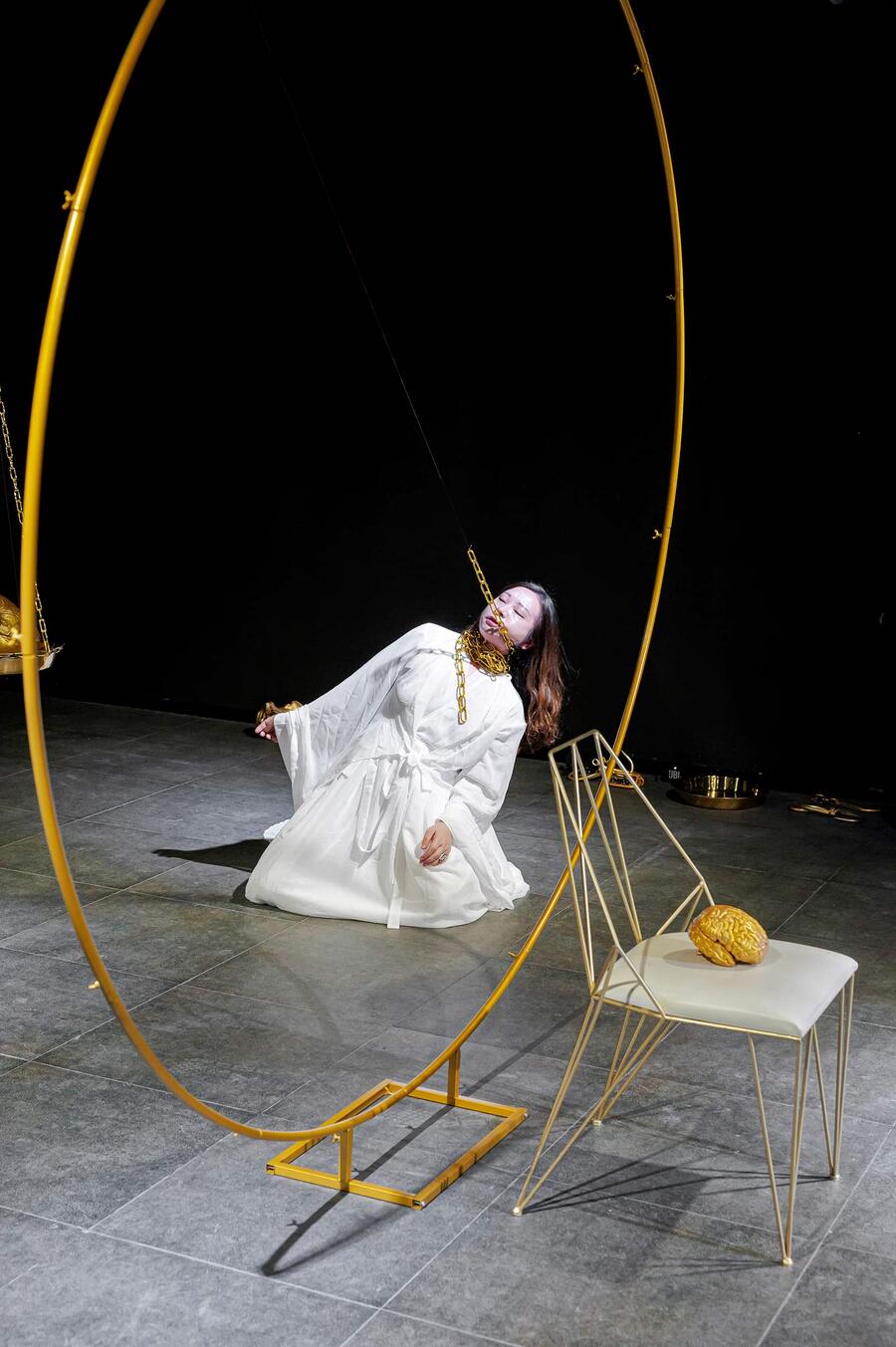
In ancient Greek mythology, humanity went through various stages, such as the Golden Age, the Silver Age, the Bronze Age, and so on. The higher the stage, the more pure and virtuous humanity was considered to be. However, due to the constant expansion of human desires, humanity fell from the Golden Age to the Silver Age, and then to the Bronze Age. After entering the Iron Age, human society became engulfed in materialistic desires. Many people forgot about morality and truth, becoming deceitful, violent, and criminal. They embarked on a path of no return, utilizing metallurgical technology to forge weapons and wage wars. Thus, the mortal world entered an era of turmoil. At this time, the gods in the heavens became disappointed in humanity, only the goddess of justice, Themis, had not lost hope in human nature. She attempted to restore humanity's true essence. The goddess of justice, Themis, sought to help people regain their lost virtues, earnestly advising people to be kind. However, Themis' efforts were like playing the lute to a cow because the people of this era had fallen too deeply into corruption.
Later, Themis held the scales of justice to discern right from wrong, truth from falsehood, in order to judge the authenticity and morality of the mortal world. This is the origin of the constellation Libra.
There is an alternative story about Libra, involving a contest between Themis and Poseidon. Poseidon believed that humanity had fallen beyond redemption, while Themis still believed that humans could change for the better. They argued relentlessly over this matter and refused to compromise, so they sought the judgment of the gods in the heavens. Hera, the queen of the gods, saw that neither of them would relent, and she suggested a competition. She posed the question: whoever could make humanity feel more peace would be the winner, and the loser would have to apologize. The gods then temporarily brought some human consciousness to the heavens, allowing them to experience the actions of Poseidon and Themis, and used a golden scale to measure the human consciousness. The stronger the sense of peace that people felt, the heavier it would weigh, determining the outcome. First, Poseidon conjured up crystal-clear water, which made people feel a sense of purity and coolness. Themis then transformed into a large tree, adorned with emerald-green leaves and olives. When people saw this olive tree, they felt an even stronger presence of peace. As a result, the golden scale tipped towards the side of the goddess of justice, and Poseidon ultimately lost the competition. Later, Zeus raised the golden scale to the starry sky, and the image of this golden scale became the constellation Libra.
In this performance, I arranged the scene with a golden circular ring, sitting on a golden geometric chair in front of the ring. On either side of me were golden human spines, pelvic bones, and brains, along with heavy iron chains and hooks. I covered my eyes with a red cloth, lifting the iron chains and human bones with each hand, extending my arms. By doing so, I transformed my body into a scale. I use my arms to support the heavy weights on each side until my strength gradually depleted. My hands sank and dropped under the force of gravity. After weighing the human bones and iron chains, I turned to the back of the circular ring, where a large golden heart was placed on one end of the balance, with a golden iron chain on the other. I wrapped the iron chain around my neck, tightening it coil by coil, and tilted my body, using the strength of my neck to pull the other end of the scale. The golden heart on the scale gradually rose, while the iron chain around my neck tightened, causing suffocation. It continued until the heart on the scale was suspended in mid-air, and my body lay prostrate on the ground.
On the scale, I placed a heart, which is a metaphor derived from ancient Egypt. The weight of the heart was used as a measure of good and evil. In ancient Egypt, this heart was weighed against the feather of Ma'at in the underworld. Ma'at was the goddess of truth and justice in ancient Egypt, with the authority to judge whether the owner of the heart was virtuous in their lifetime. If the deceased's heart was lighter than Ma'at's feather, they would have eternal life in the afterlife. If the heart was heavier than the feather, it would be immediately devoured by the monster Ammit waiting beneath the scale.
Here, measuring the heart is also measuring good and evil, measuring social justice. The iron chain tied around my neck also incorporates the concept of the iron chain event, becoming a measure of judging social justice.
Xinmo Theater - Day Six: "Prometheus"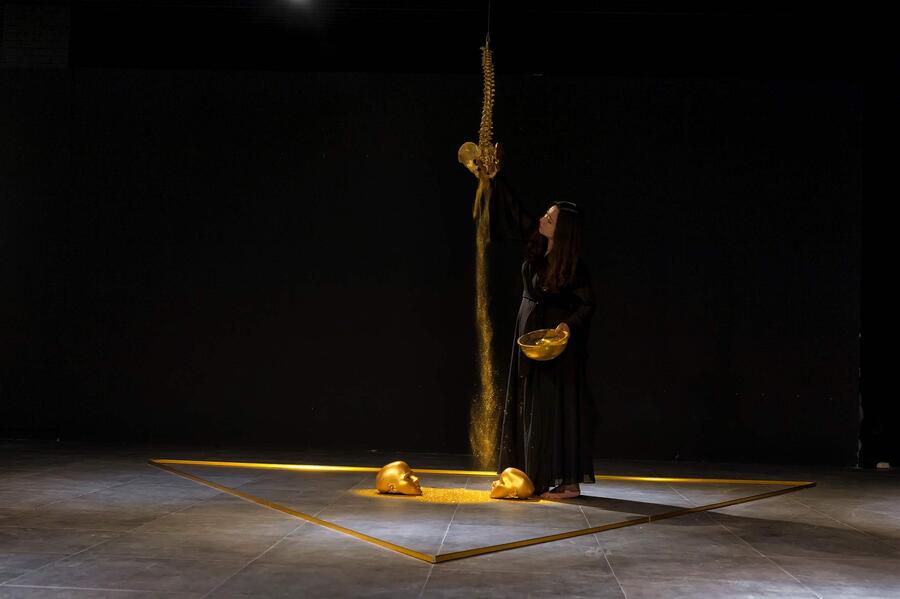
Prometheus, one of the Titans in Greek mythology, is born to Iapetus—the son of Gaia and Uranus—and Clymene, and is the brother of Epimetheus. Prometheus, along with the goddess Athena, created humans. Prometheus molded the shape of humans from clay, while Athena infused them with souls and taught them many things. Prometheus also rebelled against Zeus and brought fire to humanity. During the Titanomachia, the war led by Zeus and Kronos, Prometheus sided with the new Olympian gods and gained Zeus's favor, allowing him to stay on Mount Olympus. Prometheus used clay to create humans in his own image and attended the meeting as their protector. During the meeting, he managed to convince the gods not to impose harsh sacrifices as a condition for protecting humans. He descended to the earth with the fire and gave it to humanity, causing the first pillar of fire to rise to the sky. Zeus became furious and ordered the fire god to punish Prometheus severely. Following Zeus's orders, the fire god and two servants took Prometheus to Mount Caucasus and bound him to a steep cliff with an unbreakable iron chain. He was condemned to never sleep, with his tired knees unable to bend, and a diamond nail was driven into his heaving chest. Zeus also sent an eagle to peck at Prometheus's liver (in ancient Greece, the liver was believed to be the seat of human emotions) every day. During the day, the liver would be completely consumed, but it would regenerate at night. This continued until Hercules happened to pass by while searching for the golden apples. Seeing the situation, Hercules shot the eagle with an arrow and smashed the iron chain with a stone, freeing Prometheus.
I installed a golden triangle on the ground at the performance venue, and above this triangle, I hung a spine and a pelvis. It is said that the spine is the gathering place of the soul, and the pelvis is the place where humans are born. I placed the golden heads of a man and a woman at the center of the triangle, symbolizing humanity. In this act, I am both Prometheus and Athena. I create the physical form of humans and infuse them with souls. I sprinkle golden powder into the two skulls, and the powder flows out from the holes on top of their heads. I place a model of the human brain inside the pelvis, and I sprinkle golden powder into the suspended pelvis, creating a shape resembling the soul. Finally, the entire triangle is covered in golden powder. Afterwards, I secure myself to the ground with an iron chain and two large stones, symbolizing the chains that bound Prometheus to the mountain. However, I replace these stones with discarded concrete blocks from a construction site, creating a connection to the real world. I crawl on the ground, struggling to drag these two stones around the triangle, and finally, I light the candle placed in the center of the triangle. Lighting the candle symbolizes fire and brightness.
Xinmo Theater - Day Seven: "The Iron Age"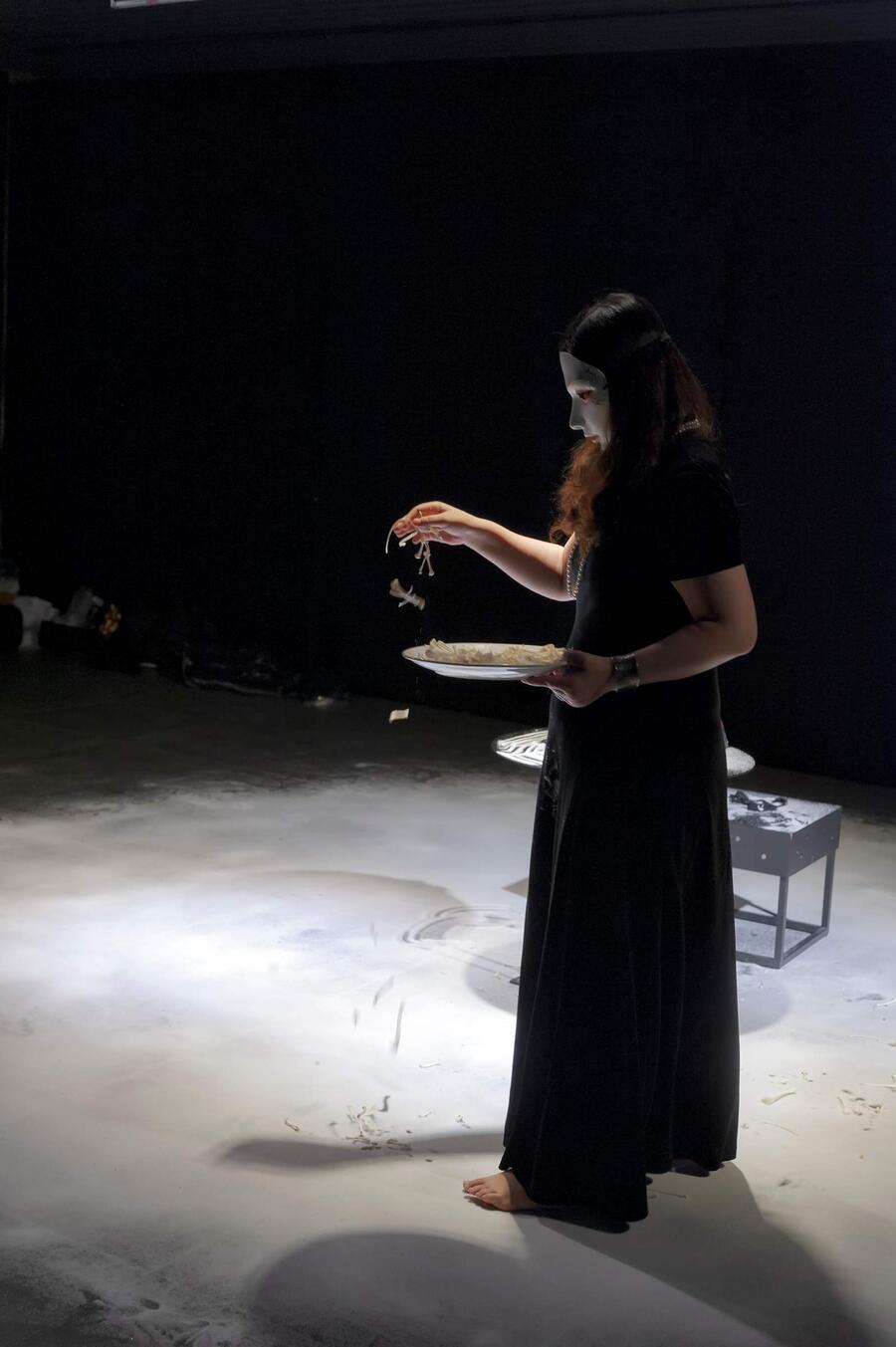
"The Iron Age" The Iron Age is the darkest era. The gods constantly bring new troubles upon humanity, and the greatest trouble are brought by themselves. Fathers do not love their sons, sons resent their fathers, masters refuse to entertain their friends, and friends hate each other. The once happy and dignified goddesses used to come to the earth, but now they sadly wrap their beautiful bodies in white robes and return to the eternal realm of the gods. All that is left for humanity is misery, and there seems to be no end to this miserable state.
This seems to be a reflection of the society we live in. The Iron Age is the last and worst era among the five ages of humanity as people harm each other, even among siblings, and the world is chaotic and disorderly, enveloped in desire and death.
At the performance venue, I create a snowy night using salt and read Bataille's "The Holy Virgin and the Dead." It is an absurd story and the origin of many absurd erotic novels. It begins with a girl sitting on a plate filled with milk, and from there, this crazy and filthy journey begins.
Bataille's work has deeply shaken me spiritually. It is not arousing one’s sexual desires, but rather the loss of our "rational" father, which has led everyone to lose themselves and meaning in irrational madness. "I try to abandon any meaning of words, such as hope or despair. But in moments of weariness, I think again that my life must ultimately have some meaning. As long as something is defined as desirable."
The story goes from filthy debauchery to killing the priest, reaching a climax.
To some extent, Bataille is allegorizing this era.
While reading about a man confessing his incestuous acts to God, I eat the bones of a bird on a plate, and then eat the salt on the ground. I read with a mask on, and the salt melts in my mouth. The ground is filled with dead birds, and I become a birdman, a bird-headed doctor from the medieval plague, an image derived from the experience of the three years of the COVID-19 pandemic. She consumes the baby on the plate. However, compassion makes her put down her knife and fork, and she picks up the baby. I then transform from a bird back into a human. I sprinkle salt on the baby's body, and I take out a heart from the Golden Age and pour black liquid on it. I cover my mouth with black cloth and sprinkle the black liquid on my face with a spoon, forming a cross on my face.
Interestingly, the final cross echoes the cross nailed to the wall with black cloth in the first day of the Golden Age. And that golden heart has also been defiled.
Seven days of performances are independent yet internally connected. Each one is related to our era.
I hope to perform through writing poems, using imagery, situations, metaphors, and symbols to create a visual poem or allegory.
I attempt to break certain boundaries or bridge certain rifts, combining theater, literature, performance, and installations all together.